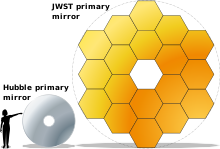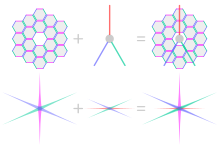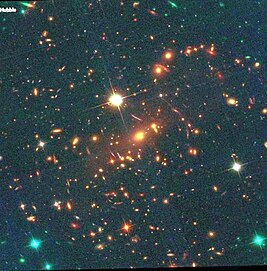Webb's First Deep Field: Difference between revisions
XOR'easter (talk | contribs) →Galaxies in the Early Universe: "published" is not a last name (double-check all automatically generated citations!); assorted phrasing fixes Tag: Reverted |
Restored last good version before utterly incoherent recent additions Tags: Manual revert Reverted references removed |
||
| Line 4: | Line 4: | ||
{{bots|deny=CommonsDelinker}} |
{{bots|deny=CommonsDelinker}} |
||
[[File:Webb's First Deep Field.jpg|thumb|Webb's First Deep Field|alt=The background of space is black. Thousands of galaxies appear all across the view. Their shapes and colors vary. Some are various shades of orange, others are white. Most stars appear blue, and are sometimes as large as more distant galaxies that appear next to them. A very bright star is just above and left of center. It has eight long, bright-blue diffraction spikes. Between 4 o'clock and 6 o'clock in its spikes are several very bright galaxies. A group of three are in the middle, and two are closer to 4 o'clock. These galaxies are part of the galaxy cluster SMACS 0723, and they are warping the appearances of galaxies seen around them. Long orange arcs appear at left and right toward the center.]] |
[[File:Webb's First Deep Field.jpg|thumb|Webb's First Deep Field|alt=The background of space is black. Thousands of galaxies appear all across the view. Their shapes and colors vary. Some are various shades of orange, others are white. Most stars appear blue, and are sometimes as large as more distant galaxies that appear next to them. A very bright star is just above and left of center. It has eight long, bright-blue diffraction spikes. Between 4 o'clock and 6 o'clock in its spikes are several very bright galaxies. A group of three are in the middle, and two are closer to 4 o'clock. These galaxies are part of the galaxy cluster SMACS 0723, and they are warping the appearances of galaxies seen around them. Long orange arcs appear at left and right toward the center.]] |
||
'''Webb's First Deep Field''' is the first [[operational image]] taken by the [[James Webb Space Telescope]] |
'''Webb's First Deep Field''' is the first [[operational image]] taken by the [[James Webb Space Telescope]]. The [[List of deep fields|deep-field]] photograph, which covers a tiny area of sky visible from the [[Southern Hemisphere]], is centered on [[SMACS 0723]], a [[galaxy cluster]] in the [[constellation]] of [[Volans]]. Thousands of [[galaxies]] are visible in the image, some as old as 13 billion years.<ref>{{cite web |title=Webb's First Deep Field (NIRSpec MSA Emission Spectra) |url=https://webbtelescope.org/contents/media/images/2022/035/01G7HRYVGM1TKW556NVJ1BHPDZ |website=WebbTelescope.org |access-date=14 July 2022 |language=en}}</ref> The image is the highest-resolution image of the [[early universe]] ever taken. Captured by the telescope's [[NIRCam|Near-Infrared Camera]] (NIRCam), the image was revealed to the public by [[NASA]] on 11 July 2022. |
||
== Background == |
== Background == |
||
| Line 17: | Line 17: | ||
The combined mass of the galaxy cluster acts as a [[gravitational lens]], magnifying and distorting the images of much more distant galaxies behind it. Webb's NIRCam brought the distant galaxies into sharp focus, revealing tiny, faint structures that had never been seen before, including [[star cluster]]s and diffuse features.<ref name=":0" /> |
The combined mass of the galaxy cluster acts as a [[gravitational lens]], magnifying and distorting the images of much more distant galaxies behind it. Webb's NIRCam brought the distant galaxies into sharp focus, revealing tiny, faint structures that had never been seen before, including [[star cluster]]s and diffuse features.<ref name=":0" /> |
||
=== Galaxies in the Early Universe === |
|||
In 2022 the JWST made another discovery: a group of six galaxies observed in the early universe.<ref name=":3">{{Cite web |last=Collen |first=Juliette |title=Webb spots surprisingly massive galaxies in early universe |url=https://phys.org/news/2023-02-webb-massive-galaxies-early-universe.html |access-date=2023-07-17 |website=phys.org |language=en}}</ref><ref name=":4">{{Cite web |first=Tereza |last=Pultarova |date=2023-02-22 |title=The James Webb Space Telescope discovers enormous distant galaxies that should not exist |url=https://www.space.com/james-webb-space-telescope-giant-distant-galaxies-surprise |access-date=2023-07-17 |website=Space.com |language=en}}</ref> The telescope found these galaxies apparently formed within 500 to 700 million years after the Big Bang 13.8 billion years ago, challenging current models of galaxy formation: the size of some galaxies was calculated to be comparable or even bigger than the [[Milky Way]], which took almost the entire life of the universe to form.<ref name=":3" /><ref name=":4" /> |
|||
In June 2023, Simon Lilly of [[ETH Zurich|ETH Zürich]] in Switzerland has proven that observation made by JSWT were indeed galaxies.<ref name=":6">{{Cite web |last=Yan |first=Isabelle |date=2023-06-12 |title=NASA's Webb Proves Galaxies Transformed the Early Universe |url=http://www.nasa.gov/feature/goddard/2023/nasa-s-webb-proves-galaxies-transformed-the-early-universe |access-date=2023-07-17 |website=NASA}}</ref> Christina Eilers from MIT also used Webb’s data to discover a black hole in the quasar at the center of the field where all these galaxies were discovered. It's was speculated that it's the most massive currently known black hole in the early universe ever formed, weighing 10 billion times the mass of the Sun.<ref name=":6" /> |
|||
== Diffraction spikes in the photo == |
== Diffraction spikes in the photo == |
||
| Line 33: | Line 28: | ||
== Significance == |
== Significance == |
||
| ⚫ | Webb's First Deep Field is the first full [[false color|false-color]] image from the JWST,<ref>{{Cite news |last=Strickland |first=Ashley |date=July 11, 2022 |title=President Biden reveals the James Webb Space Telescope's stunning first image |website=[[CNN]] |url=https://www.cnn.com/2022/07/11/world/james-webb-space-telescope-first-image-scn/index.html |url-status=live |access-date=2022-07-12 |archive-url=https://web.archive.org/web/20220712040743/https://www.cnn.com/2022/07/11/world/james-webb-space-telescope-first-image-scn/index.html |archive-date=2022-07-12}}</ref> and the highest-resolution infrared view of the universe yet captured. The image reveals thousands of galaxies in a tiny sliver of the universe, with Webb's sharp near-infrared view bringing out faint structures in extremely distant galaxies, offering the most detailed view of the early universe to date. Thousands of galaxies, which include the faintest objects ever observed in the infrared, have appeared in Webb's view for the first time.<ref>{{Cite news |last=Chow |first=Denise |date=July 11, 2022 |title=The Webb telescope's first full-color photo is here – and it's stunning |url=https://www.nbcnews.com/science/space/james-webb-space-telescope-first-color-photo-rcna37584 |url-status=live |archive-url=https://web.archive.org/web/20220712040742/https://www.nbcnews.com/science/space/james-webb-space-telescope-first-color-photo-rcna37584 |archive-date=2022-07-12 |access-date=2022-07-11 |website=[[NBC News]]}}</ref><ref name=":0" /> |
||
=== Deepest image of the Universe === |
|||
{{Main|List of deep fields}} |
|||
| ⚫ | |||
It was first revealed to the public during an event on 11 July 2022 by U.S. President [[Joe Biden]].<ref name=":2">{{Cite news |last1=Overbye |first1=Dennis |last2=Chang |first2=Kenneth |last3=Tankersley |first3=Jim |date=2022-07-11 |title=Biden and NASA Share First Webb Space Telescope Image |language=en-US |work=[[The New York Times]] |url=https://www.nytimes.com/2022/07/11/science/nasa-webb-telescope-images-livestream.html |url-status=live |access-date=2022-07-12 |archive-url=https://web.archive.org/web/20220712005736/https://www.nytimes.com/2022/07/11/science/nasa-webb-telescope-images-livestream.html |archive-date=2022-07-12 |issn=0362-4331}}</ref> |
It was first revealed to the public during an event on 11 July 2022 by U.S. President [[Joe Biden]].<ref name=":2">{{Cite news |last1=Overbye |first1=Dennis |last2=Chang |first2=Kenneth |last3=Tankersley |first3=Jim |date=2022-07-11 |title=Biden and NASA Share First Webb Space Telescope Image |language=en-US |work=[[The New York Times]] |url=https://www.nytimes.com/2022/07/11/science/nasa-webb-telescope-images-livestream.html |url-status=live |access-date=2022-07-12 |archive-url=https://web.archive.org/web/20220712005736/https://www.nytimes.com/2022/07/11/science/nasa-webb-telescope-images-livestream.html |archive-date=2022-07-12 |issn=0362-4331}}</ref> |
||
Revision as of 20:35, 18 July 2023

Webb's First Deep Field is the first operational image taken by the James Webb Space Telescope. The deep-field photograph, which covers a tiny area of sky visible from the Southern Hemisphere, is centered on SMACS 0723, a galaxy cluster in the constellation of Volans. Thousands of galaxies are visible in the image, some as old as 13 billion years.[1] The image is the highest-resolution image of the early universe ever taken. Captured by the telescope's Near-Infrared Camera (NIRCam), the image was revealed to the public by NASA on 11 July 2022.
Background
The James Webb Space Telescope is a space telescope operated by NASA and designed primarily to conduct infrared astronomy. Launched in December 2021, the spacecraft has been in a halo orbit around the second Sun–Earth Lagrange point (L2), about 1.5 million kilometers (900,000 mi) from Earth, since January 2022. At L2, the gravitational pull of the Sun combines with the gravitational pull of the Earth to produce an orbital period that matches Earth's, and the Earth and Sun remain co-aligned (as seen from that point) as the Earth and the spacecraft orbit the Sun together.[2]
Webb's First Deep Field was taken by the telescope's Near-Infrared Camera (NIRCam) and is a composite produced from images at different wavelengths, totalling 12.5 hours of exposure time.[3][4]
SMACS 0723 is a galaxy cluster visible from Earth's Southern Hemisphere,[5] and has often been examined by Hubble and other telescopes in search of the deep past.[2]
Scientific results
The image shows the galaxy cluster SMACS 0723 as it appeared 4.6 billion years ago,[4] covering an area of sky with an angular size approximately equal to a grain of sand held at arm's length.[3] Many of the objects in the image have undergone notable redshift due to the expansion of space over the extreme distance traveled by the light radiating from them.[6] The redshifts of nearly 200 of these objects have been measured to date,[7] with the highest redshift measured at 8.498.[8]
The combined mass of the galaxy cluster acts as a gravitational lens, magnifying and distorting the images of much more distant galaxies behind it. Webb's NIRCam brought the distant galaxies into sharp focus, revealing tiny, faint structures that had never been seen before, including star clusters and diffuse features.[3]
Diffraction spikes in the photo


The six bright and two fainter spikes around the point sources of light in the photo are an artifact created by the physical limitations of the telescope. The six bright spikes are a result of diffraction from the mirror's edges. The mirror is composed of 18 individual units, each having the shape of a regular hexagon. The hexagonal rim of the units that make up the telescope's large mirror give rise to the six spikes.[9] Telescopes with circular mirrors/lenses don't have such spikes (in lieu of spikes, diffraction from circular rims creates a pattern of concentric rings called Airy discs).
The two additional spikes are a result of diffraction from the struts holding the telescope's secondary mirror in front of the main mirror. As shown in the figure on the right, diffraction from the three struts creates six spikes, but four of these are designed to co-align with the spikes created from the diffraction caused by the rim. This leaves the two faint horizontal spikes visible in the photo.[10]
Significance
Webb's First Deep Field is the first full false-color image from the JWST,[11] and the highest-resolution infrared view of the universe yet captured. The image reveals thousands of galaxies in a tiny sliver of the universe, with Webb's sharp near-infrared view bringing out faint structures in extremely distant galaxies, offering the most detailed view of the early universe to date. Thousands of galaxies, which include the faintest objects ever observed in the infrared, have appeared in Webb's view for the first time.[12][3]
It was first revealed to the public during an event on 11 July 2022 by U.S. President Joe Biden.[2]
Comparison with the Hubble Space Telescope
The following images are a comparison with the image taken by the Hubble Space Telescope and the image taken by Webb of the same galaxy cluster.
Right: same image taken by the James Webb Space Telescope in 2022[19]
See also
References
- ^ "Webb's First Deep Field (NIRSpec MSA Emission Spectra)". WebbTelescope.org. Retrieved 14 July 2022.
- ^ a b c Overbye, Dennis; Chang, Kenneth; Tankersley, Jim (11 July 2022). "Biden and NASA Share First Webb Space Telescope Image". The New York Times. ISSN 0362-4331. Archived from the original on 12 July 2022. Retrieved 12 July 2022.
- ^ a b c d Garner, Rob (11 July 2022). "NASA's Webb Delivers Deepest Infrared Image of Universe Yet". NASA. Archived from the original on 11 July 2022. Retrieved 11 July 2022.
- ^ a b "Webb's first deep field". European Space Agency. 12 July 2022. Archived from the original on 12 July 2022. Retrieved 11 July 2022.
- ^ "SRELICS". IRAS. Archived from the original on 12 July 2022. Retrieved 12 July 2022.
- ^ Isaacs-Thomas, Isabella (11 July 2022). "Here's the deepest, clearest infrared image of the universe ever produced". PBS. Archived from the original on 12 July 2022. Retrieved 12 July 2022.
- ^ Noirot, Gaël; Desprez, Guillaume; Asada, Yoshihisa; Sawicki, Marcin; Estrada-Carpenter, Vicente; Martis, Nicholas; Sarrouh, Ghassan; Strait, Victoria; Abraham, Roberto; Bradač, Maruša; Brammer, Gabriel; Iyer, Kartheik; MacFarland, Shannon; Matharu, Jasleen; Mowla, Lamiya (14 December 2022). "The first large catalogue of spectroscopic redshifts in Webb's First Deep Field, SMACS J0723.3$-$7327". arXiv:2212.07366.
{{cite journal}}: Cite journal requires|journal=(help) - ^ Carnall, A. C.; Begley, R.; McLeod, D. J.; Hamadouche, M. L.; Donnan, C. T.; McLure, R. J.; Dunlop, J. S.; Milvang-Jensen, B.; Bondestam, C. L.; Cullen, F.; Jewell, S. M.; Pollock, C. L. (9 November 2022). "A first look at the SMACS0723 JWST ERO: spectroscopic redshifts, stellar masses and star-formation histories". Monthly Notices of the Royal Astronomical Society: Letters. 518 (1): L45–L50. arXiv:2207.08778. doi:10.1093/mnrasl/slac136. ISSN 1745-3925.
- ^ Williams, Matt (19 March 2022). "Wondering About the 6 Rays Coming out of JWST's Test Image? Here's why They Happen". Universe Today. Archived from the original on 16 July 2022. Retrieved 15 July 2022.
- ^ "Webb's Diffraction Spikes".
- ^ Strickland, Ashley (11 July 2022). "President Biden reveals the James Webb Space Telescope's stunning first image". CNN. Archived from the original on 12 July 2022. Retrieved 12 July 2022.
- ^ Chow, Denise (11 July 2022). "The Webb telescope's first full-color photo is here – and it's stunning". NBC News. Archived from the original on 12 July 2022. Retrieved 11 July 2022.
- ^ Garner, Rob (11 July 2022). "NASA's Webb Delivers Deepest Infrared Image of Universe Yet". NASA. Archived from the original on 12 July 2022. Retrieved 12 July 2022.
- ^ Overbye, Dennis; Chang, Kenneth; Tankersley, Jim (11 July 2022). "Biden and NASA Share First Webb Space Telescope Image – From the White House on Monday, humanity got its first glimpse of what the observatory in space has been seeing: a cluster of early galaxies". The New York Times. Archived from the original on 12 July 2022. Retrieved 12 July 2022.
- ^ Pacucci, Fabio (15 July 2022). "How Taking Pictures of 'Nothing' Changed Astronomy - Deep-field images of "empty" regions of the sky from Webb and other space telescopes are revealing more of the universe than we ever thought possible". Scientific American. Retrieved 16 July 2022.
- ^ Deliso, Meredith; Longo, Meredith; Rothenberg, Nicolas (14 July 2022). "Hubble vs. James Webb telescope images: See the difference". ABC News. Retrieved 15 July 2022.
- ^ Kooser, Amanda (13 July 2012). "Hubble and James Webb Space Telescope Images Compared: See the Difference - The James Webb Space Telescope builds on Hubble's legacy with stunning new views of the cosmos". CNET. Retrieved 16 July 2022.
- ^ Atkinson, Nancy (2 May 2022). "Now, We can Finally Compare Webb to Other Infrared Observatories". Universe Today. Archived from the original on 10 May 2022. Retrieved 12 May 2022.
- ^ Chow, Denise; Wu, Jiachuan (12 July 2022). "Photos: How pictures from the Webb telescope compare to Hubble's - NASA's $10 billion telescope peers deeper into space than ever, revealing previously undetectable details in the cosmos". NBC News. Retrieved 16 July 2022.






